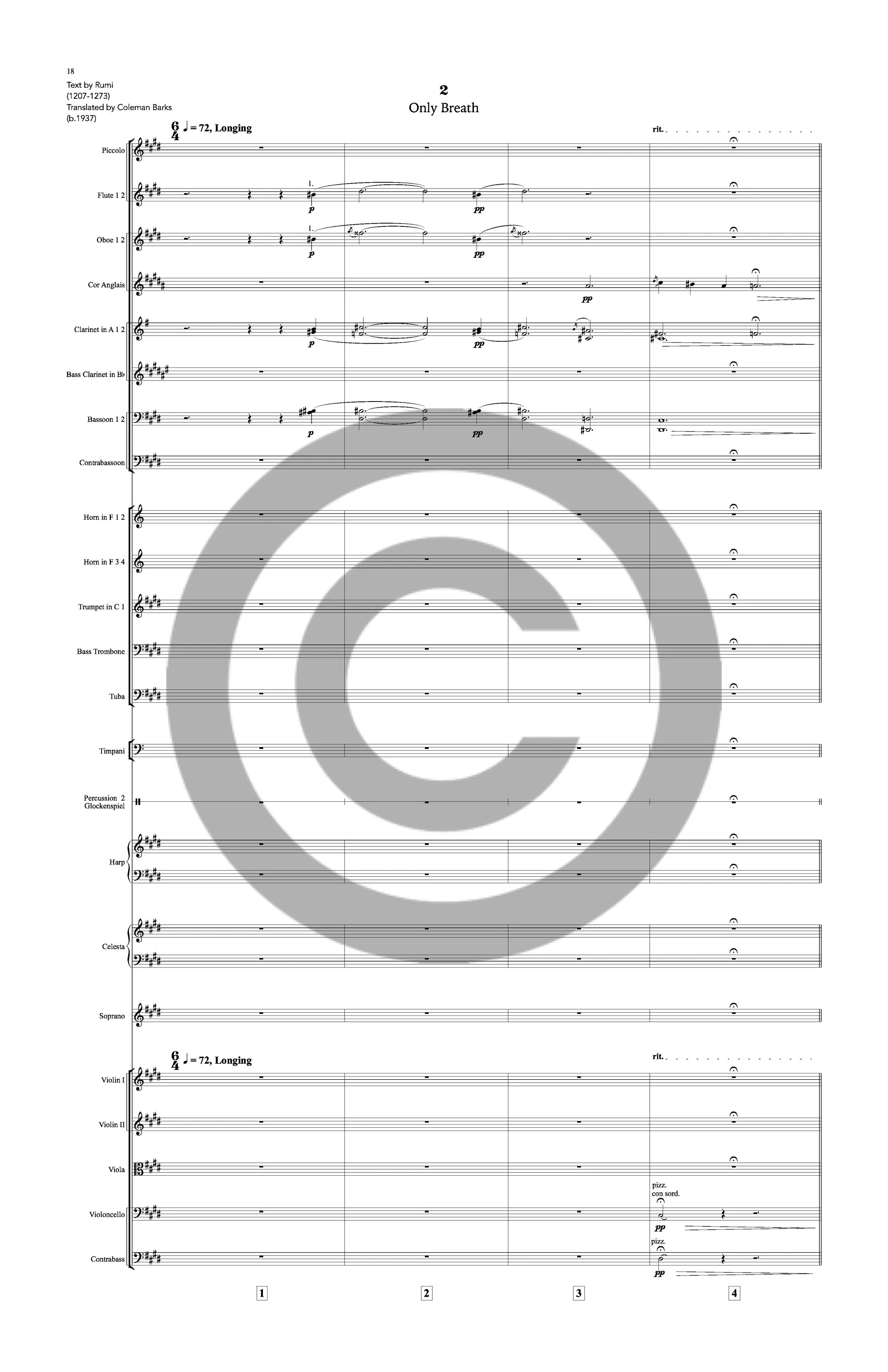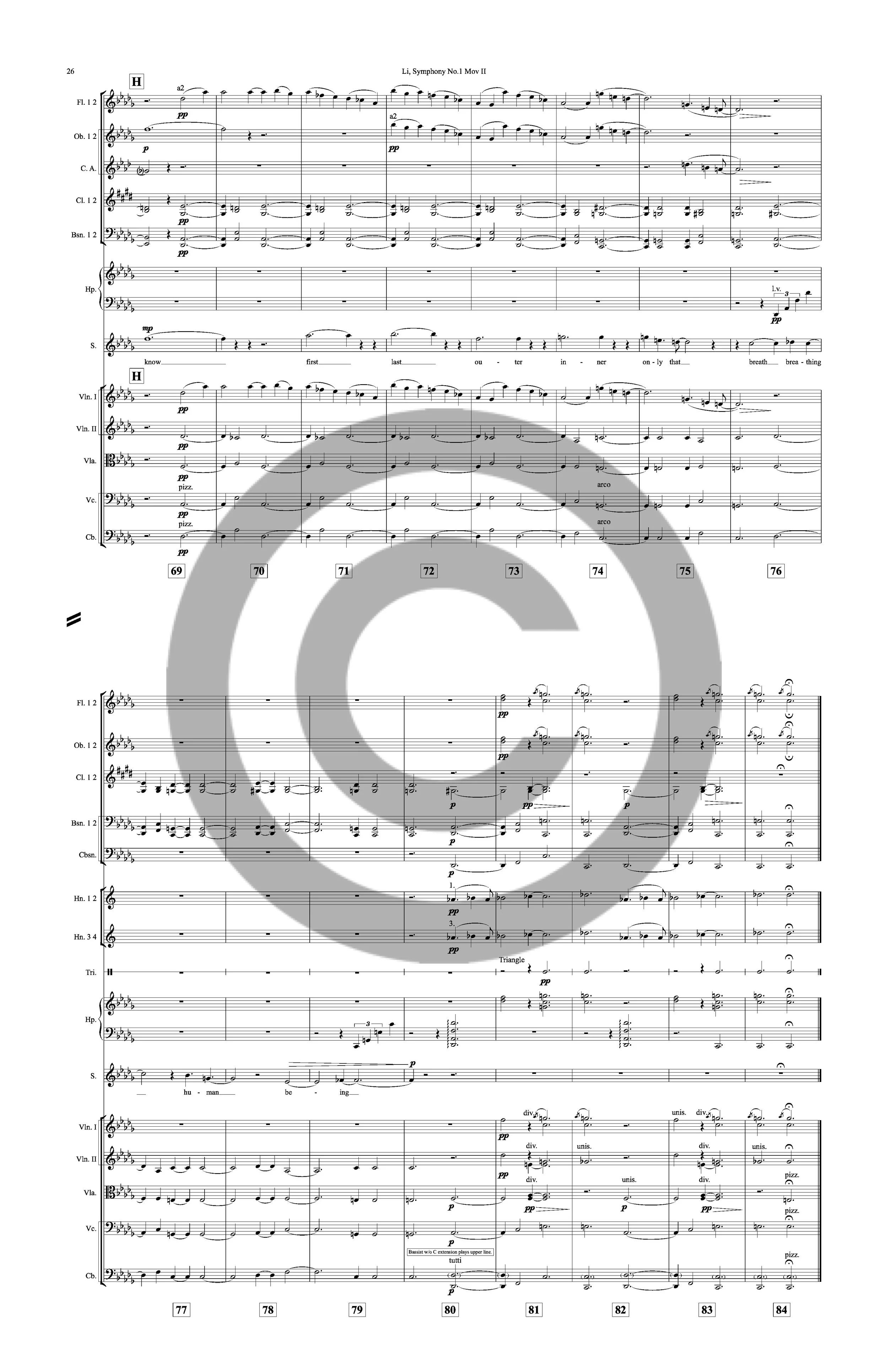Symphony No.1 “Only Breath”
for full orchestra and solo soprano
Movement III, “Rejoice! Humans!”
Movement II, “Only Breath” - Reduced Orchestra Version
Movement II, “Only Breath” - Two Pianos and Voice Arrangement
-
YEAR: April 2020 - March 2021
DURATION: 26’
INSTRUMENTATION: (3[1.2.3/pic] 3/Eh. 3/bcl. 3/cbsn, - 4.3.3.1 – Timp+3, hp, pno, ST, SOLO SOP)
ARRANGEMENTS: Two pianos and voice version
Reduced orchestra and voice version for Movement II - Only Breath.
(2/pic, 1/Eh. 2. 2/cbsn, - 2.1 – Timp+1, hp, ST, SOLO SOP)
PREMIERE: Two pianos and voice arrangement premiered on March 30,2021, Robert J. Werner Recital Hall, University of Cincinnati College-Conservatory of Music, Cincinnati, OH
TEXTS: Only Breath by (1207-1273), Translated by Coleman Barks (b.1937), from THE ESSENTIAL RUMI
PARTS: Movement I - Darkness Falls
Movement II - Only Breath
Movement III - Rejoice! Humans!
-
...I am not from the East or the West, not out of the ocean or up
from the ground, not natural or ethereal, not composed of elements at all. I do not exist,
am not an entity in this world or in the next, did not descend from Adam and Eve or any
origin story. My place is placeless, a trace of the traceless. Neither body or soul.
I belong to the beloved, have seen the two worlds as one and that one call to and know,
first, last, outer, inner, only that breath breathing human being.
- Rumi (1207-1273), Translated by Coleman Barks (b.1937)
“Only Breath”
Translated by Coleman Barks, from THE ESSENTIAL RUMI Copyright © 1995 by Coleman Barks
Used with permission of Coleman Barks
-
2020 was a year anything but normal. Globalism comes to a halt, with nationalism ideals starting to manifest in every region. Not only does the virus takes people’s breath, also people violently take each other’s breath. What is it that makes people alienate each other for centuries? Dunbar’s number gave one explanation of the tribal nature of human society; however, I refuse to accept it. Then, I stumble upon the old wisdom of an ancient Middle eastern poet and philosopher, Rumi. His poem, “Only Breath,” shed light on the matter and is the central idea of this whole work - to remember what makes us human, to love and embrace it. Eventually, humans will band together and head to a bright future.
After my last orchestral piece, I wanted to take on an ambitious project, using the ultimate form of symphonic work – a Symphony, to represent one’s life during the time of the covid-19 pandemic. It summarizes as a journey from darkness (Mov I) to a philosophical discovery of the commonality of human nature (Mov II), leading to the celebration of ultimate joy and happiness (Mov III). Lastly, I would like to thank my professor, Dr. Douglas Knehans, who help me achieved my artistic goals and provided valuable insight to my music.
Movement I – Darkness Falls
It begins from a rumbling, unregular pulse, symbolic oscillation like an ambulance siren. The music is full of turmoil, gradually builds tension and speed, reaching to a tragic climax and discord ending.
Movement II – Only Breath
Composed for soprano and orchestra, this movement evokes a strong soul who refused to be defined by anyone and wanders in this world, searching for the meaning of being human. It starts with woodwinds playing a longing theme, connected by the strings imitating a breath-like motion. The music gets warmer as it progresses, ending on a major sonority, with the French horns reminding the struggles from the first movement, now with acceptance and peace.
Movement III – Rejoice! Humans!
This movement encompasses everything that makes us happy in life—a fanfare like start leads to a worry-free melody. The heart and soul of this movement is the Adagio section, inspired by the scenery of Tybee Island, Savannah, GA. The fanfare motive becomes the accompaniment, and the worry-free motive transcends into a tender melody. In the end, the struggles in the first movement now become a triumphant ending to the whole symphony.








